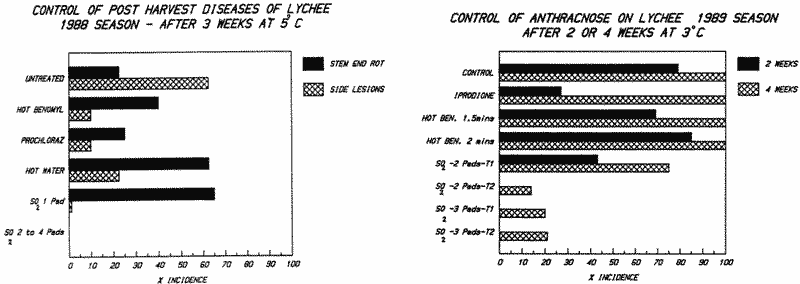
LYCHEE DISEASE CONTROL
SCIENTIFIC NAME: Litchi chinensis
FAMILY: Sapindaceae
1. INTRODUCTION
During two seasons (1988 and 1989), sulphur dioxide slow release pads (Grapeguard) and fungicides have been evaluated for control of postharvest disease of Lychee cv Kwai May Pink during storage at 5°C. Treatments were evaluated (% of fruit affected by disease) after two and four weeks, with separate experimental units of fruit evaluated on each occasion. Isolations were made from all lesions in at least one replicate to determine the cause of the lesions.
2. RESULTS
In the 1988 trial, problems with isolation techniques prevented an accurate assessment of the pathogens involved. These problems were resolved in 1989 and Anthracnose (Colletotrichum gloeosporioides) was the major cause of disease losses.
Sulphur dioxide (3 pads/punnet of 20 fruit) provided good control of disease (Table 1). Unfortunately the treatment caused skin-bleaching. Partial colour recovery occurred after the pads were removed. In the 1988 trial, prochloraz also provided good control, but caused unacceptable tainting (Schering PTL unpublished). In the 1989 trial, iprodione also provided good control of anthracnose.
Iprodione is already registered for postharvest use on stone fruit in Australia. Another season's work is required to further assess disease control efficacy and to obtain samples for residue and taint testing.
 | |
| CONTROL OF POST HARVEST DISEASES OF LYCHEE 1988 SEASON - AFTER 3 WEEKS AT 5°C | CONTROL OF ANTHRACNOSE ON LYCHEE 1989 SEASON AFTER 2 OR 4 WEEKS AT 3°C |
DATE: September 1989
* * * * * * * * * * * * *
